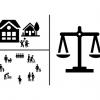The main objective of WP4 is to develop a conceptual framework of the Social Exposome that captures the entirety of exposures of the social and psychosocial environment. This conceptual framework will help us understand how social characteristics and structural disadvantages affect inequalities in environmental exposures and can also determine differential effects of environmental exposures that together influence cognitive development and mental health among children and young people.
WP4 focuses on the social and psychosocial factors that infants (pre-, peri-, postnatal), children, and adolescents experience as individuals, or as members of a family or community – their so called‚ Social Exposome'. We will investigate how these factors impact on environmental inequalities, the children’s/young people’s vulnerability to the health effects from these environmental exposures in the Physical Exposome, and ultimately their development, cognitive functioning, and mental health. The conceptual framework that will be developed will also address how inequalities arise and are maintained in the Social Exposome and relate this to environmental inequalities in the Physical Exposome (together, the External Exposome).
This understanding of embodying inequalities will enable the development of indicators of the Social Exposome that can be applied to assess intermediate and differential health effects of ‘exposures’ within the Social Exposome, allowing the analysis of large groups of children/young people from across Europe. In addition, where and how children and young people from different social backgrounds spend their time at different life stages will be collected in the form of time-activity patterns and used as input for WP4. Based on the Health Equity in All Policies approach, a further objective is to assess how these inequalities in the Social and Physical Exposome are minimized or reinforced in particular contexts by policies from different sectors.
18 month update
WP4 aims to extend the Exposome concept with the social domain, capturing exposures from the social and psychosocial environment that children are living in.
At the beginning of the funding period, the Equal-Life consortium shared a highly diverse range of ideas on what the Social Exposome is. Based on this, a conceptual framework was developed including the social determinants of health and environmental health inequalities (environmental justice). The model stresses the multi-layered nature and relations of multiple factors on health, development, and well-being. Among the included factors are: socioeconomic factors (e.g. education), sociodemographic factors (e.g. migration background), psychosocial factors (e.g. social interactions), and cultural factors (e.g. social norms).
To better understand children’s social and physical exposures, the so-called time-activity exposure patterns amongst children and young people are studied at different ages and social groups and how children and young people spend their time, and what noise they are exposed to.
Currently, WP4 is working on how the Social Exposome can be measured and adequately assessed using specific indicators and metrics. This work will help inform the analysis of the school and cohort studies within Equal-Life.
WP4 will also look into the health equity impact of interventions and policies from different sectors. This work will include case studies selected for the analysis of the equity impacts of these policies.
WP4 has also been participating in the European Human Exposome Network (EHEN, see WP11 and the EHEN website) events, presenting information on the Social Exposome, coordinating sessions, and supporting the EHEN partner collaboration. Equal-Life is one of the few projects within the network that studies the social exposome extensively.
